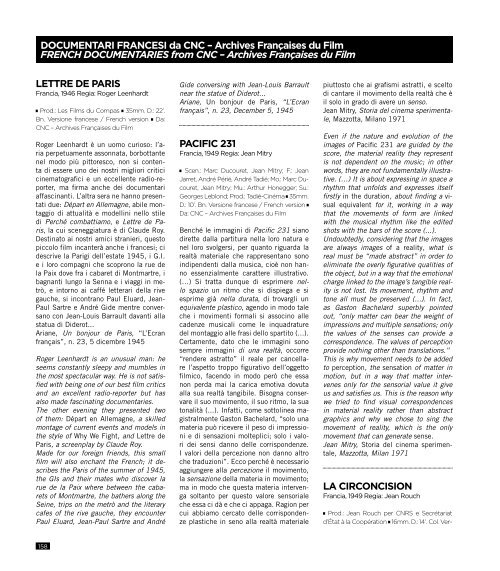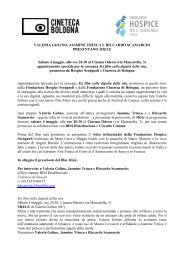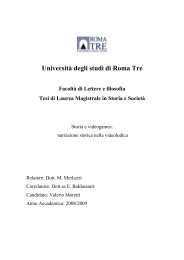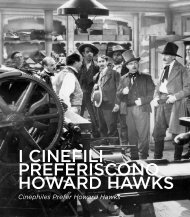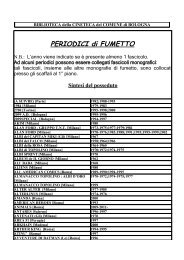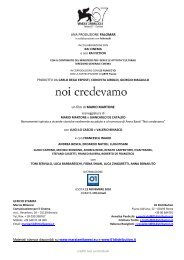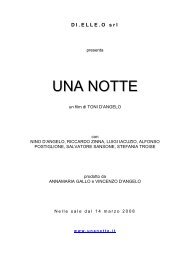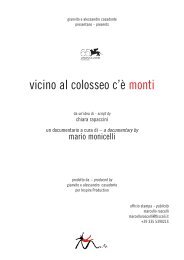Ritrovati & Restaurati sonori.pdf - Cineteca di Bologna
Ritrovati & Restaurati sonori.pdf - Cineteca di Bologna
Ritrovati & Restaurati sonori.pdf - Cineteca di Bologna
Create successful ePaper yourself
Turn your PDF publications into a flip-book with our unique Google optimized e-Paper software.
DOCUMENTARI FRANCESI da CNC – Archives Françaises du Film<br />
FRENCH DOCUMENTARIES from CNC – Archives Françaises du Film<br />
LETTRE DE PARIS<br />
Francia, 1946 Regia: Roger Leenhardt<br />
█ Prod.: Les Films du Compas █ 35mm. D.: 22’.<br />
Bn. Versione francese / French version █ Da:<br />
CNC – Archives Françaises du Film<br />
Roger Leenhardt è un uomo curioso: l’aria<br />
perpetuamente assonnata, borbottante<br />
nel modo più pittoresco, non si contenta<br />
<strong>di</strong> essere uno dei nostri migliori critici<br />
cinematografici e un eccellente ra<strong>di</strong>o-reporter,<br />
ma firma anche dei documentari<br />
affascinanti. L’altra sera ne hanno presentati<br />
due: Départ en Allemagne, abile montaggio<br />
<strong>di</strong> attualità e modellini nello stile<br />
<strong>di</strong> Perché combattiamo, e Lettre de Paris,<br />
la cui sceneggiatura è <strong>di</strong> Claude Roy.<br />
Destinato ai nostri amici stranieri, questo<br />
piccolo film incanterà anche i francesi; ci<br />
descrive la Parigi dell’estate 1945, i G.I.<br />
e i loro compagni che scoprono la rue de<br />
la Paix dove fra i cabaret <strong>di</strong> Montmartre, i<br />
bagnanti lungo la Senna e i viaggi in metrò,<br />
e intorno ai caffé letterari della rive<br />
gauche, si incontrano Paul Eluard, Jean-<br />
Paul Sartre e André Gide mentre conversano<br />
con Jean-Louis Barrault davanti alla<br />
statua <strong>di</strong> Diderot...<br />
Ariane, Un bonjour de Paris, “L’Ecran<br />
français”, n. 23, 5 <strong>di</strong>cembre 1945<br />
Roger Leenhardt is an unusual man: he<br />
seems constantly sleepy and mumbles in<br />
the most spectacular way. He is not satisfied<br />
with being one of our best film critics<br />
and an excellent ra<strong>di</strong>o-reporter but has<br />
also made fascinating documentaries.<br />
The other evening they presented two<br />
of them: Départ en Allemagne, a skilled<br />
montage of current events and models in<br />
the style of Why We Fight, and Lettre de<br />
Paris, a screenplay by Claude Roy.<br />
Made for our foreign friends, this small<br />
film will also enchant the French; it describes<br />
the Paris of the summer of 1945,<br />
the GIs and their mates who <strong>di</strong>scover la<br />
rue de la Paix where between the cabarets<br />
of Montmartre, the bathers along the<br />
Seine, trips on the metrò and the literary<br />
cafes of the rive gauche, they encounter<br />
Paul Eluard, Jean-Paul Sartre and André<br />
158<br />
Gide conversing with Jean-Louis Barrault<br />
near the statue of Diderot...<br />
Ariane, Un bonjour de Paris, “L’Ecran<br />
français”, n. 23, December 5, 1945<br />
PACIFIC 231<br />
Francia, 1949 Regia: Jean Mitry<br />
█ Scen.: Marc Ducouret, Jean Mitry; F.: Jean<br />
Jarret, André Périé, André Ta<strong>di</strong>é; Mo.: Marc Ducouret,<br />
Jean Mitry; Mu.: Arthur Honegger; Su.:<br />
Georges Leblond; Prod.: Ta<strong>di</strong>é-Cinéma █ 35mm.<br />
D.: 10’. Bn. Versione francese / French version █<br />
Da: CNC – Archives Françaises du Film<br />
Benché le immagini <strong>di</strong> Pacific 231 siano<br />
<strong>di</strong>rette dalla partitura nella loro natura e<br />
nel loro svolgersi, per quanto riguarda la<br />
realtà materiale che rappresentano sono<br />
in<strong>di</strong>pendenti dalla musica, cioè non hanno<br />
essenzialmente carattere illustrativo.<br />
(…) Si tratta dunque <strong>di</strong> esprimere nello<br />
spazio un ritmo che si <strong>di</strong>spiega e si<br />
esprime già nella durata, <strong>di</strong> trovargli un<br />
equivalente plastico, agendo in modo tale<br />
che i movimenti formali si associno alle<br />
cadenze musicali come le inquadrature<br />
del montaggio alle frasi dello spartito (...).<br />
Certamente, dato che le immagini sono<br />
sempre immagini <strong>di</strong> una realtà, occorre<br />
“rendere astratto” il reale per cancellare<br />
l’aspetto troppo figurativo dell’oggetto<br />
filmico, facendo in modo però che essa<br />
non perda mai la carica emotiva dovuta<br />
alla sua realtà tangibile. Bisogna conservare<br />
il suo movimento, il suo ritmo, la sua<br />
tonalità (...). Infatti, come sottolinea magistralmente<br />
Gaston Bachelard, “solo una<br />
materia può ricevere il peso <strong>di</strong> impressioni<br />
e <strong>di</strong> sensazioni molteplici; solo i valori<br />
dei sensi danno delle corrispondenze.<br />
I valori della percezione non danno altro<br />
che traduzioni”. Ecco perché è necessario<br />
aggiungere alla percezione il movimento,<br />
la sensazione della materia in movimento;<br />
ma in modo che questa materia intervenga<br />
soltanto per questo valore sensoriale<br />
che essa ci dà e che ci appaga. Ragion per<br />
cui abbiamo cercato delle corrispondenze<br />
plastiche in seno alla realtà materiale<br />
piuttosto che ai grafismi astratti, e scelto<br />
<strong>di</strong> cantare il movimento della realtà che è<br />
il solo in grado <strong>di</strong> avere un senso.<br />
Jean Mitry, Storia del cinema sperimentale,<br />
Mazzotta, Milano 1971<br />
Even if the nature and evolution of the<br />
images of Pacific 231 are guided by the<br />
score, the material reality they represent<br />
is not dependent on the music; in other<br />
words, they are not fundamentally illustrative.<br />
(…) It is about expressing in space a<br />
rhythm that unfolds and expresses itself<br />
firstly in the duration, about fin<strong>di</strong>ng a visual<br />
equivalent for it, working in a way<br />
that the movements of form are linked<br />
with the musical rhythm like the e<strong>di</strong>ted<br />
shots with the bars of the score (...).<br />
Undoubtedly, considering that the images<br />
are always images of a reality, what is<br />
real must be “made abstract” in order to<br />
eliminate the overly figurative qualities of<br />
the object, but in a way that the emotional<br />
charge linked to the image’s tangible reality<br />
is not lost. Its movement, rhythm and<br />
tone all must be preserved (...). In fact,<br />
as Gaston Bachelard superbly pointed<br />
out, “only matter can bear the weight of<br />
impressions and multiple sensations; only<br />
the values of the senses can provide a<br />
correspondence. The values of perception<br />
provide nothing other than translations.”<br />
This is why movement needs to be added<br />
to perception, the sensation of matter in<br />
motion, but in a way that matter intervenes<br />
only for the sensorial value it give<br />
us and satisfies us. This is the reason why<br />
we tried to find visual correspondences<br />
in material reality rather than abstract<br />
graphics and why we chose to sing the<br />
movement of reality, which is the only<br />
movement that can generate sense.<br />
Jean Mitry, Storia del cinema sperimentale,<br />
Mazzotta, Milan 1971<br />
LA CIRCONCISION<br />
Francia, 1949 Regia: Jean Rouch<br />
█ Prod.: Jean Rouch per CNRS e Secrétariat<br />
d’État à la Coopération █ 16mm. D.: 14’. Col. Ver-


